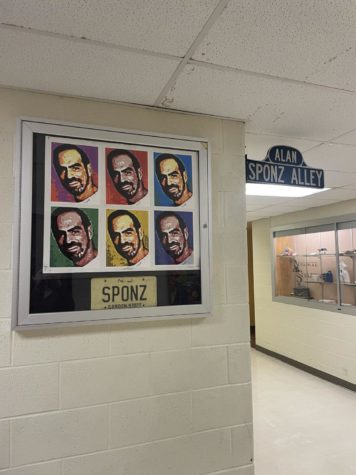The People Around You
Stopping the Stigma on Mental Illness
*Indicates that a name has been changed to protect the confidentiality of those who shared their stories.
Chained to a bed, her arms and legs were immobile. Her lips were glued shut and her lungs were filled with cement. Before she restrained herself to her bed, she shut all the blinds so that the only light was the time on her alarm clock. 3:05 a.m. She watched the ceiling fan race around rhythmically, awestruck at how fast it spun. Her body had long lost the capability to move so quickly. Even her thoughts lagged, they crept slowly around her brain like molasses. A single idea clamped itself to her brain refusing to leave. She ran her fingers over pink scars dashed on her thighs while she pondered how her life might end. Tears crawled behind her eyes, but she was too tired to cry. She was too tired to think. Eventually she drifted to sleep.
She woke up blinded by rays of light shooting through the cracks of her blinds. Her mother walked in with a handful of pills. Prozac, 40 mg. Lamotrigine, 25 mg. Wellbutrin, 200 mg. She swallowed her meds, lifted her heavy legs to the floor, and started yet another dreaded day.
Mornings like this are not uncommon across the youth of America. According to The National Alliance on Mental Illness, one in five children, ages 13 to 18, have some type of mental illness.
A mental illness is a chemical imbalance that can morph the way one thinks, feels, and behaves. Most common include major depressive disorder (MDD), clinical anxiety, and bipolar disorder. Depression causes a persistent low mood, lack of energy, and often suicidal tendencies. Anxiety is a paralyzing worry about the future, and bipolar disorder causes extreme manic and depressive episodes. During a manic episode one may go a week without sleep because of excessive energy. This can lead them to participate in reckless and unsafe activities that they would not do otherwise. Depressive episodes may last several weeks and have the same symptoms of major depressive disorder, such as low mood and suicidal habits. Depending on the severity of these illnesses, they may lead to death.
Suicide is the second leading cause of death for ages 10 to 24. For this statistic to be true, something in society must be off. Many believe this anomaly is due to a lack of education about mental health, which has led to unfair societal stigmas. Although millions of people deal with a mental illness, many still feel alone or judged because the topic is so rarely discussed.
Look around you, have you witnessed jokes about suicide? What would you think if you found out someone was admitted to a mental hospital? Do you think people who take antidepressant or antipsychotic medications are ‘crazy’?
Many think mental health is a joke or an excuse and not a serious issue. Many think it is a topic so severe that it does not commonly exist around them at all. Due to an absence of knowledge of the subject, most people don’t know the truth– that everyone deals with mental health issues in their lives.
Psychiatric hospitals do exist, and no they aren’t for serial killers. Not everyone who is depressed is suicidal. ‘Goth’ or ‘emo’ teenagers do not necessarily cut or self harm. Seemingly perfect people are not always as happy as they might seem. A smile can mean anything.
Take a closer look at the people around you.
Coping
Traits are passed down from parent to offspring through genes. It is likely that a brown haired, green eyed mother will have a brown haired, green eyed child.
Similarly, a parent’s habits and behaviors mold their child’s personality and social skills. A child raised in a violent home may grow to be a violent adult.
The nature versus nurture theory applies to almost all aspects of human development.
Luke, Marilyn, and Perry Sinclair* are all blond. Luke and his sister Marilyn are both tall. His dad is a diehard Red Sox fan just like he is. Mental illness is also a common issue among the Sinclair family.
When Luke was in sixth grade, he began to notice changes in his life. He often found himself hiding in school bathrooms, upset without reason or leaving class exhausted to sleep at the nurse’s office. His older sister, Marilyn, was struggling with her own problems and was seeing a therapist to cope with that. As this was the parents second time around, they were more educated on this type of behavior. His parents brought Luke to Marilyn’s therapist who recommended him to another professional. Luke began meeting with his own therapist a few times a month. After a few sessions with Luke, his therapist came to the conclusion to diagnose him with depression.
Over the next few years, Luke Sinclair periodically met with therapists and physiatrists who aided in treating his mental illness.
Talking to doctors was difficult for Luke. Psychiatrists do not meet with their patients as often as therapists do, and they do not always have the ability to build strong, trusting relationships. Speaking to a near stranger about one’s most personal issues can be scary, and trusting them is even harder.
“It’s not that you lie, but sometimes you’re not completely honest with them,” Luke said. “I feel like part of it is because you feel like you can help yourself with it and treat it on your own.”
Dealing with mental illnesses independently is often more appealing than sharing with professionals because the reality of the issue is not forced upon the patient, but coping with mental illness alone does just the opposite of healing.
Professionals have an in-depth education on coping and management and provide skills that cannot be learned anywhere else. They talk to people with a wide range of situations and diagnoses, so chances are, they have dealt with a problem just like yours. Verbalizing issues for the first time can be difficult, so a strong step is to talk to family and other trusted adults first.
Luke’s family was a critical asset to his recovery.
His father, Anthony Sinclair*, struggles with bipolar disorder. Bipolar I is a mood disorder that causes intense manic and depressive episodes. A manic episode causes elevated energy, lack of sleep, and the urge to do unsafe and risky. A depressive episode causes deflated energy, and a consistent low mood that often leads to suicidal thoughts.
After dealing with bipolar disorder, Mr. Sinclair developed a long list of coping skills to pass on to his son. He taught Luke how to safely and effectively deal with his depression. Luke’s older sister, Marilyn, also dealt with similar issues. She was another important emotional outlet for Luke.
Today, Luke Sinclair is exceeding in school and is a pitcher for his school’s baseball team. He has found a healthy corner for his depression, so he has room for the things that make him happy.
Living
To overcome any issue, the first step is accepting that you have one. But if your problem hides in the neurochemicals in your brain and doesn’t reveal itself to the conscious mind, how is one supposed to realize that there is something that needs to be fixed? Many young children exist around their friends miserably for years before the realize that the dark cloud over their head is not normal. For many, the problem is left unnoticed until it becomes unmanageable. A select few have the ability to recognize the irregularities in the way they are living.
As just a young middle schooler, Domenic Biamonte began to realize that his moods were not the same as his friends. He was feeling tired and sad and wasn’t enjoying things that he used to. He kept this in the back of his head until his freshman year of high school when he decided that the way he was feeling was not acceptable. He was distancing himself from his friends and missing days of school just to sleep. His appetite almost completely vanished which was causing him to lose an unhealthy amount of weight. His grades were beginning to plummet and he was just overall uncomfortable with his life. Instead of letting the problem grow, he courageously opened up to his parents and asked for help.
After meeting with several psychiatrists, psychologists, and therapists, Biamonte was diagnosed with clinical depression and anxiety at the age of 15.
Following his diagnosis, Biamonte began taking antidepressant medications. Medication is a crucial treatment to recovery but it is often overlooked in the mental health field.
Taking medication for mental illness can sometimes be uncomfortable. Besides managing possible side effects, people are also tasked to deal with negative stigma.
“I didn’t want to be one of those kids who’s on meds because they have depression,” Biamonte said. He was afraid that people would perceive taking a medication to change his mood as some kind of illicit drug problem, even though it was prescribed. “I was afraid people were going to judge me and say ‘Oh he’s a pill popper, he can’t control himself.”

As diabetic takes insulin or an asthmatic uses an inhaler, prescribing antidepressants is a medical treatment, the same as any other illness.
Biamonte was doing well. His grades were back up and when he was feeling low he met with his guidance counselor, Mr. Dan Brodhead. This was a crucial in-school outlet, but was not sufficient enough on its own. His counselor did all he could to help Biamonte, but he ended up looking to a professional for a more educated aid.
His parents worked out a schedule with a therapist and he began seeing him often. Like any other thing, it was difficult in the beginning. Venting about subjects he usually only revealed to himself was a new experience.
It was new for his family too. It was “an abstract concept” to the Biamontes, as no one had ever participated in therapy before.
“My family was always, come to the family, the family deals with it, you get better. I was the first one to do that so I was sort of walking into new territory,” Biamonte said.
He eventually became accustomed to speaking about his depression and learned began picking up on characteristics of himself he had never seen before. His thought processes were becoming more positive and he was coping healthily.
But it was not all. Biamonte’s sophomore year was anything but positive. He was walking the path of suicide. He was contemplating taking his life more and more often.
He soon found himself at rock bottom.
It was the day before that last day of his sophomore year. His dad left to pick up sandwiches and he found himself in a new, scary situation. At home he was planning out how he was going to end his life. There was a plethora of options for him to choose from. Hanging himself, overdosing, cutting himself. But just as Biamonte had in middle school, he asked for help before anything dangerous could happen.
He made a brave decision and called the National Suicide Prevention Lifeline.
The Lifeline is a free and confidential phone hotline open 24/7 that anyone can call during an emergency. When you call, you are connected with a volunteer crisis worker that will help you through your individual crisis.
Anyone in need of emotional help can call the Lifeline. They can guide you through a wide range of situations including bullying, relationships, and physical, emotional, and drug related abuse.
Biamonte’s crisis worker calmed him down and evaluated the situation. The volunteer’s job is to distract the person from doing anything unsafe until someone can take over the situation in person, but if the volunteer deems the situation dangerous, it is their responsibility to call an ambulance to the location of the of the patient.
Unfortunately, this was the case for Biamonte. Police officers arrived at his door to prevent him from committing suicide. Because this is a life threatening medical emergency, they were obligated to take him to the hospital, but they needed a parent’s permission. When his father returned, he gave his son the opportunity to choose– did he want to go to the hospital or could he be trusted to stay home?
Most people take the precautionary path and do go to the hospital to be evaluated, but Biamonte trusted himself to stay safe at home. Luckily, this was the right choice for him and his family.
The next few month started looking up. His junior and senior year went by, and though he was still struggling, he was doing much better.
The biggest change was his understanding of the world. He came to realize the immensity of mental health problems today, but more importantly that there is a huge support system for anyone that needs it.
Mental illnesses is something that is only spoken in hushed voices. The extreme sides are easier to understand. People can picture an ‘insane’ person constrained in straightjacket in an asylum, and they themselves already know what it mean to be sad, but the in between is difficult to comprehend. Most people find themselves in between the two extremes, more than sad, but less than insane.
It can be a terrifying experience, but coming out to the world with your illness is freeing.
At first Biamonte was nervous about coming out with his illness. He lived in Glen Rock since the day he was born and met some of his classmates as early as preschool. Once he let go, he felt relieved, freed, and accepted. “It’s weird to think that I thought didn’t belong. Now I know I’m wanted because I opened myself up,” Biamonte said.
His senior year is passing and in a few months he will be leaving Glen Rock. In June, Biamonte is graduating high school with the class of 2017 and a few months later he starts his freshman year at Syracuse’s Business School for Finance and Accounting. The steps he took to stay healthy, stable, and alive are now making themselves known as he makes his way into adulthood.
Dealing
Her purple hair highlighted the blonde and brown heads in the sea of middle schoolers. Her thick black eyeliner masked her sunken eyes just as her black jeans hid her scar striped legs. She walked the hallways without a friend.
The only conversations Juliette Burgess* held were with herself in her head contemplating when and how she was going to commit suicide. She was isolated with only her mind for all of middle school.
Halfway through Burgess’s freshman year she was admitted to an inpatient facility at Four Winds Hospital for depression.
Four Winds Hospital is an inpatient and outpatient psychiatric hospital for all ages. Located in Saratoga, New York, Four Winds provides individualized and constant therapy for patients as well as a treatment team to guide a safe life after release from care.
Burgess participated in group therapy through which she developed healthy coping skills and supportive friendships.
A week later she left Four Winds and went to an out patient program at High Focus. For two months her schooling at Glen Rock High School was replaced by a tutoring sessions and group and individual therapy. Both her physical and mental health were improving.
Unfortunately, after all the progressions Burgess made, she took up at dangerous habit.
Burgess began smoking weed and drinking routinely. To her it seemed to make her happier– she had friends, she was having fun, and she was confident, but as a teenager without a steady job, she was running low on money. In addition to using, Burgess began selling too. Her spirits were higher than they had been in years.
The beginning of her senior year was starting out great. Burgess was becoming more and more comfortable and open about her life, and eventually began posting about dealing on social media.
A family hired Burgess for a weekend babysitting job when the situation escalated. She watched four and seven year old sisters while their mother was in D.C. for three days in September. At 5 p.m., Burgess and the girls were playing when they heard a knock on the door.
The girls’ eyes widened and filled with tears as they saw three officers, large and intimidating, standing in the doorway. The police were anonymously sent a screenshot of one of Burgess’s social media posts and went on to arrest Burgess for child endangerment, possession, among other charges.
Burgess was shattered. “My parents will never trust me, my life is over. I’m never going to get into college. I ruined my life and I’m only 16,” she said.
She was terrified for the future ahead of her and seriously contemplated suicide.
Two days later, she returned to an inpatient program called Carrier Clinic for a week. Unfortunately, her second hospitalization was nothing like her first. Her stay at the cottage style Four Winds Hospital was calming and educational. At the Carrier Clinic, Burgess and the other patients were cooped up in a room all day except for their meals in the cafeteria. Without any activities and proper therapy, all the patients were miserable.
A white plaster ceiling blocked the sun and sky, two aspects of nature that had previously helped her cope with her mental illness.
“I’m obsessed with the sky, when you look at it, it’s all around you, there’s no stop. It just goes on forever. And when I think about it, the stuff that I’m going through is so small compared to everything else, it’s not always going to be relevant. I know that what I’m going through sucks, but I have this insane hope that it won’t be like this forever,” Burgess said.
For seven days she ate cereal three meals a day, as the other food provided upset her stomach. Even the staff, one of the most crucial parts of any hospital, were not helpful. Burgess and the staff argued throughout her stay. “I felt like I was in a prison,” she said.
Juliette Burgess was soon released to the care of her parents and the High Focus Center once again. She attended High Focus in place of school for several months. Her time was similar to her prior experience, but with one added component- she was to be drug tested three times a week. This was degrading reality to Burgess. Handing a cup of urine to a nurse over and over again for months was humiliating, but overall was essential to her recovery.
She became stronger and eventually healed enough to go back to school.

Home was better, but still hard. Burgess is a private person, she prefers to keep her thoughts to herself, but when it comes to mental health, this is not always the best option. Her parents needed transparency to be confident in her safety. She wanted to give them that security but it was a struggle. She did not want her parents constantly watching her as if she was a child, but also did not want to come to them by herself.
“I would rather sit and watch TV with a bowl of cereal than with another person,” Burgess said.
But, there was one person she always felt comfortable with.
Burgess met her best friend when she was 12. It was not a constant friendship, they had their ups and downs like most, but she claims that her best friend knows her better than anyone. No topic is off the table for the girls. “We are really close and we’re going to be friends for a long time,” Burgess said.
Like most, even with all her treatment, her mental health problems have not disappeared. There are days when the only company she can tolerate are her pet Chihuahua and labradoodle, but there are also moments when she is ecstatic to be alive.
The sky symbol was an essential component to her recovery. The deep blue immenseness follows her everywhere and keeps her safe, on track, and positive.
“Just keep pushing, everyone, I don’t know that it will get better, but things will change and it won’t be this forever,” she said, always keeping the sky in mind.

Kate Casey is a senior at Glen Rock High School and this is her fourth and final year writing for The Glen Echo. She volunteers at a tutoring program for...







Kathleen Schmidt • Jun 9, 2017 at 11:20 am
Kate,
You may not realize this now, but you have done a great service to your peers by writing this piece. It’s honest and gives a much needed window into what’s going on with kids and their mental health. People of all ages tend not to understand mental illness unless they’ve experienced it themselves or have been close to someone who has some form of it.
You’re a gifted writer–I hope you keep up the good work.
Liz Cox • Jun 8, 2017 at 6:11 pm
Kate,
What a fantastic & eye opening article. I think every student should read this to know they are not alone. Thank you for bring a topic that is often secretive and dreaded into the open. I
You are a fantastic journalist.
Eileen Murphy • Jun 8, 2017 at 7:54 am
I am so impressed with this article. Kate, you must be very highly regarded by your peers to get so many o f them to trust you and speak honestly about their experiences. Articles like this will go a long way to ending the stigma of mental illness. I applaud your writing and your research! Well done.
Lynn Horton • Jun 9, 2017 at 6:19 pm
What a well written article Kate. Mental illness is a reality for so many people. You shed light on a very important topic. Your story was candid and well researched! You have such a gift with words.
Steve Williams • Jun 8, 2017 at 1:37 am
Kate, this is a very well researched and written article. You did a great job explaining various mental health issues and their complexities. Thanks to you for selecting this topic and those who were courageous in sharing their stories. All involved have helped to open the dialogue about mental health and to de-stigmatize this health issue. Continue the dialogue!!
Ann Feige • Jun 7, 2017 at 2:22 pm
Wow! Kate, what a powerful article. Well researched and written, and so compassionate. Thank you for highlighting this important topic and for sharing these stories with us.